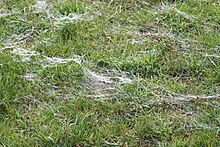
The raft spider, scientific name Dolomedes fimbriatus, is a large semi-aquatic spider of the family Pisauridae found throughout north-western and central Europe. It is one of only two species of the genus Dolomedes found in Europe, the other being the slightly larger Dolomedesplantarius which is endangered in the UK.

Phidippus audax, the bold jumper or bold jumping spider, is a common species of spider belonging to the genus Phidippus, a group of jumping spiders easily identified by their large eyes and their iridescent chelicerae. Like all jumping spiders, they have excellent stereoscopic vision that aids them in stalking prey and facilitates visual communication with potential mates during courting. Bold jumping spiders are native to North America and have been introduced to Hawaii, Nicobar Islands, Azores, and the Netherlands. They are typically black with a distinct white triangle on their abdomen.
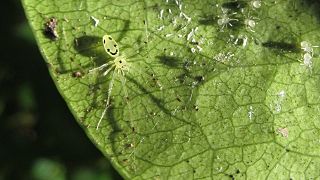
Theridion grallator, also known as the Hawaiian happy-face spider, is a spider in the family Theridiidae that resides on the Hawaiian Islands. T. grallator gets its vernacular name of "Hawaiian happy-face spider" from the unique patterns superimposed on its abdomen, specifically those that resemble a human smiling face. T. grallator is particularly notable because of its wide range of polymorphisms that may be studied to allow a better understanding of evolutionary mechanisms. In addition to the variety of color polymorphisms present, T. grallator demonstrates the interesting quality of diet-induced color change, in which its appearance temporarily changes as it metabolizes various food items.

Misumena vatia is a species of crab spider with a holarctic distribution. In North America, it is called the goldenrod crab spider or flower (crab) spider, as it is commonly found hunting in goldenrod sprays and milkweed plants. They are called crab spiders because of their unique ability to walk sideways as well as forwards and backwards. Both males and females of this species progress through several molts before reaching their adult sizes, though females must molt more to reach their larger size. Females can grow up to 10 mm (0.39 in) while males are quite small, reaching 5 mm (0.20 in) at most. Misumena vatia are usually yellow or white or a pattern of these two colors. They may also present with pale green or pink instead of yellow, again, in a pattern with white. They have the ability to change between these colors based on their surroundings through the molting process. They have a complex visual system, with eight eyes, that they rely on for prey capture and for their color-changing abilities. Sometimes, if Misumena vatia consumes colored prey, the spider itself will take on that color.
Spider behavior refers to the range of behaviors and activities performed by spiders. Spiders are air-breathing arthropods that have eight legs and chelicerae with fangs that inject venom. They are the largest order of arachnids and rank seventh in total species diversity among all other groups of organisms which is reflected in their large diversity of behavior.

Nephila pilipes is a species of golden orb-web spider. It resides all over countries in East and Southeast Asia as well as Oceania. It is commonly found in primary and secondary forests and gardens. Females are large and grow to a body size of 30–50 mm, with males growing to 5–6 mm. It is the second largest of the orb-weaving spiders apart from the recently discovered Nephila komaci. The first, second, and fourth pairs of legs of juvenile females have dense hairy brushes, but these brushes disappear as the spider matures.
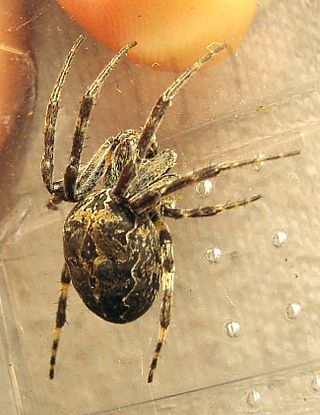
Larinioides sclopetarius, commonly called bridge-spider or gray cross-spider, is a relatively large orb-weaver spider with Holarctic distribution. These spiders originated in Europe, have been observed as south as the Mediterranean Coast and as north as Finland, and have been introduced to North America. They are often found on bridges, especially near light and over water. The species tends to live on steel objects and is seldom seen on vegetation. Females reach a body length of 10–14mm, and males 8–9mm. Their orb webs can have diameters of up to 70 cm.

Stegodyphus is a genus of velvet spiders that was first described by Eugène Simon in 1873. They are distributed from Africa to Europe and Asia, with one species found in Brazil. The name is derived from Ancient Greek στέγω, meaning "covered".

Stegodyphus lineatus is the only European species of the spider genus Stegodyphus. Male S. lineatus can grow up to 12 mm long while females can grow up to 15 mm. The colour can range from whitish to almost black. In most individuals the opisthosoma is whitish with two broad black longitudinal stripes. Males and females look similar, but the male is generally richer in contrast and has a bulbous forehead. The species name refers to the black lines on the back of these spiders. S. lineatus is found in the southern Mediterranean region of Europe and as far east as Tajikistan.
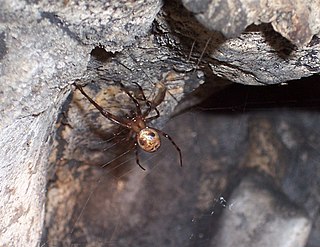
Meta menardi, the European cave spider, is a long-jawed orb-weaving spider. It is also known as the orbweaving cave spider, the cave orbweaver and, in context, simply the cave spider.
Different types of flying kites have niche applications. In nature, some animals, such as spiders, also make use of kiting.

.

Spiders are air-breathing arthropods that have eight limbs, chelicerae with fangs generally able to inject venom, and spinnerets that extrude silk. They are the largest order of arachnids and rank seventh in total species diversity among all orders of organisms. Spiders are found worldwide on every continent except for Antarctica, and have become established in nearly every land habitat. As of November 2023, 51,673 spider species in 136 families have been recorded by taxonomists. However, there has been debate among scientists about how families should be classified, with over 20 different classifications proposed since 1900.

Pisaurina mira, also known as the American nursery web spider, is a species of spider in the family Pisauridae. They are often mistaken for wolf spiders (Lycosidae) due to their physical resemblance. P. mira is distinguished by its unique eye arrangement of two rows.
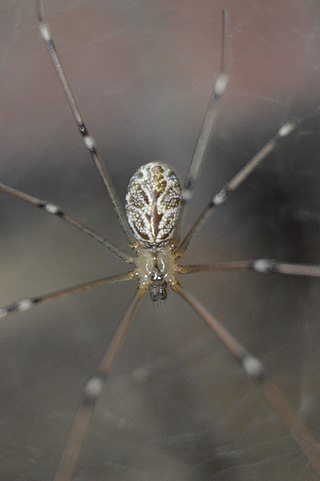
Holocnemus pluchei, commonly known as the marbled cellar spider, is a species of Pholcidae, a family commonly referred to as "cellar spiders" or "daddy long-legs". This species is distributed across the North Pacific region of the United States, as well as in parts of North Africa, Europe, and the Mediterranean. It is considered a common household spider and builds its nest in attics, basements, and eaves of houses. Although some members of the species live in solitary webs, the majority join already existing webs and migrate to new webs multiple times throughout the course of their lives. A unique feature of H. pluchei is that while in many species of spiders, stridulation commonly occurs by males during sexual encounters, in H. pluchei, females also possess stridulatory organs, and both sexes engage in stridulation.
Anelosimus jabaquara is a species of spider found in subtropical, humid, lowland forests in Brazil. Anelosimus jabaquara was first described by Herbert W. Levi in 1956. These spiders cooperate to spin and repair the colonial web, capture prey, and care for the brood. Colony size is small, and the sex ratio is biased towards females.
Stegodyphus sarasinorum, also known as the Indian cooperative spider, is a species of velvet spider of the family Eresidae. It is native to India, Sri Lanka, Nepal, and Myanmar. This spider is a social spider that exhibits communal predation and feeding, where individuals live in large cooperatively built colonies with a nest or retreat constructed of silk woven using leaves, twigs, and food carcasses, and a sheet web for prey capture.
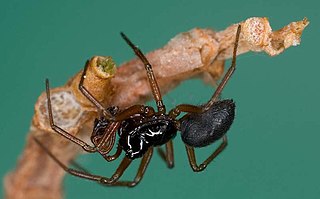
Erigone atra is a species of dwarf spider or money spider, in the family Linyphiidae. It is commonly found in North America, Europe, parts of Russia, Central Asia, China, Mongolia, Korea, and Japan. This spider is one of the most common Erigone spiders. E. atra is an important spider for agriculture, as it preys on pests such as aphids which are commonly found on crops. E. atra spiders are aeronautical spiders, as they travel via ballooning. This technique, sometimes referred to as kiting, allows E. atra spiders to traverse large distances and find new habitats when environmental or human stresses create unfit living environments. E. atra is difficult to differentiate from other congeneric species because of their similar sizes and coloring.

Stegodyphus dumicola, commonly known as the African social spider, is a species of spider of the family Eresidae, or the velvet spider family. It is native to Central and southern Africa. This spider is one of three Stegodyphus spiders that lives a social lifestyle. This spider has been studied living in large natal colonies in large, unkempt webs. Each colony is composed mainly of females, where a minority act as reproducers, and a majority remain childless and take care of the young. Males live a shorter lifespan, during which they will largely remain in the natal nest. Females are known for extreme allomaternal care, since all females – even unmated virgin ones – will take care of the young until they are eventually consumed by the brood.

Leucauge mariana is a long-jawed orb weaver spider, native to Central America and South America. Its web building and sexual behavior have been studied extensively. Males perform several kinds of courtship behavior to induce females to copulate and to use their sperm.



